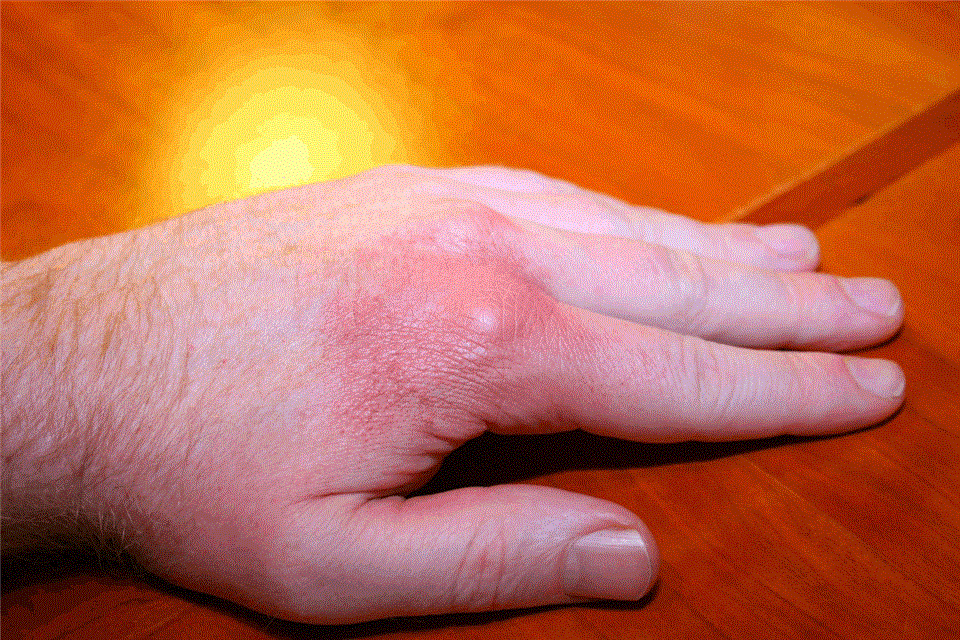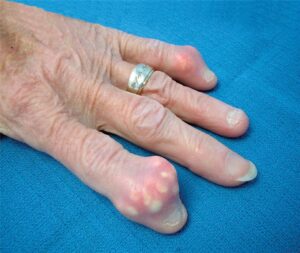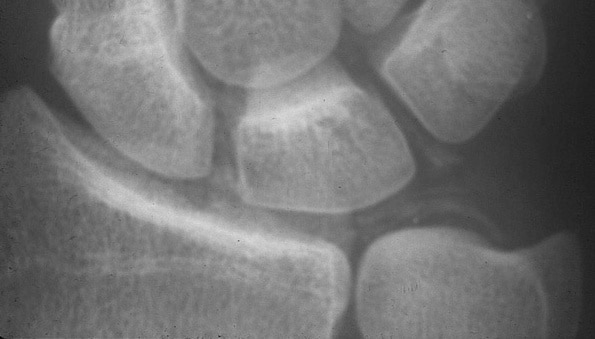Description
Gout is a type of arthritis that results in sore joints. With gout, crystals form in the joint. This causes irritation that is sometimes also present in the tendons near the joint. With gout, joints can become swollen, painful, and red (Figure 1).
Goutcan affect any joint in the body. The first gout attack often occurs in the big toe.
The elbow, wrist, and finger joints are also common sites of gout. Painful swelling can come and go in the same joint or in different joints.

Figure 1: Acute gout episode with a swollen, red and painful finger
Causes
Gout crystals form when your body makes too much, or does not get rid of, uric acid. Genetics is the main factor in determining uric acid levels. These levels can also be affected by:
- Certain medications including medicine for high blood pressure, diuretics (water pills), some blood thinners, and a medicine called cyclosporine, which is used for patients who have had a transplanted organ
- Consuming meat, seafood, and alcohol (this can raise uric acid levels)
Obesity, insulin resistance, high cholesterol, heart disease, hypothyroidism, and kidney disease can be associated with gout. Episodes of gout have been noted after injury or surgery, sometimes involving infection or the use of contrast for x-rays. Physical fitness seems to help with prevention of gout.
Signs and Symptoms
Gout leads to attacks, or flares, that appear suddenly with hot, red, or swollen joints. The joints can be so painful that they hurt to move. Sometimes the joints look like they are infected, even though they are not.
Gout crystals can form white bumps called “tophi,” which are often visible under the skin (Figure 2). These bumps are not painful.

Figure 2: Gout with tophus formation in the index and little fingers
Doctor Examination
The diagnosis for gout is made based on a physical examination by your doctor, x-rays, and lab tests. You will be asked about your symptoms and how gout has changed your activities. Because medications and other diseases can cause gout, you will be asked to provide a medical history and a medication list.
Uric acid does not show up on x-rays, but some bone changes can be visible with gout (Figure 3). If needed, fluid from the joint can be removed with a needle to confirm the gout diagnosis. Blood tests may be ordered to check for infection as well to check your uric acid levels.

Figure 3 X-ray of finger with longstanding gout. Erosions are present in the bone at the end joint as well as swelling of the soft tissue.
Treatment
When a painful episode of gout begins, the goal is to decrease swelling, redness, and pain. New episodes of gout are often treated with non-steroidal anti-inflammatory (NSAID) medication or a medicine called colchicine. Steroid pills and shots may be used to treat goutas well.
Nonsurgical Options
Episodes of gout often come and go. When the gout episodes are infrequent, an NSAID or colchicine can be used as needed. For more frequent gout episodes, other medications can be given that are managed by your primary care doctor or a rheumatologist.
Gout is usually treated without surgery. There are medicines, splints, and compression modalities to help swelling and lessen the gout pain. If your gouthas worn out the joints, or if tendons have been hurt, surgery may be needed.
If gout is not treated, the inflammation can cause damage to joints and tendons. Crystal deposits on tendons can cause the skin to wear down, which can lead to infection. In addition, tendons can tear, which can lead to loss of function.
Talk to your doctor about the best treatment plan for your gout.
